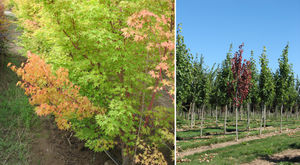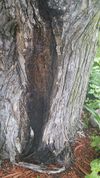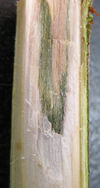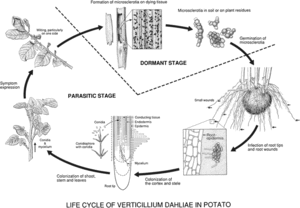Verticillium Wilt

Verticillium wilt is the result of a soil-borne fungal pathogen called Verticillium dahliae that infects over 200 species of plants[1]. In all there are ten recognized species of Verticillium but V. dahliae has the widest range of hosts. These can include maple trees, elm trees, tomato plants, eggplants, peach trees, black raspberry, spinach, pumpkin, alfalfa, hops, cotton, cherry trees, peony, snapdragons, chrysanthemums, etc[1]. As stated, there are over 200 species that may act as a host, of which includes many important agriculture crops or forest species.

V. dahliae belongs to the ascomycota genus of fungi, more commonly known as sac-fungi[9]. Ascomycota can reproduce sexually and asexually, however V. dahliae reproduce asexually though conidia[9].
Signs and Symptoms

There are many signs and symptoms of Verticillium Wilt that a host plant may exhibit. These include wilting of the leaves, chlorosis (yellowing of the leaves), stunted plant growth[1], the edges of the leaves my appear "scorched" or brown, and dead twigs and branches may appear. Specifically on maples areas of dead bark, called cankers, may appear[2].

These symptoms may appear on one side of the plant as a whole, one branch, or one grouping of leaves. Symptoms are most noticeable from mid to late summer or during times of extreme heat or drought[1].
Symptoms expressed are dependent on the host for example, in spinach or cauliflower symptoms don't appear until the plant begins to flower[1].
When a cross section is taken, infected branches on trees will show dark green or brown rings[1]. This is because verticillium infects and spreads through the vascular systems of its hosts, this disrupts the water and mineral transportation to the branches and leaves of the hosts[3]. While vascular staining occurs often, it is not always present[3].
A mixture of defense mechanisms from the infected host, along with enzymatic reactions from the fungus, lead to the degradation of the host vascular system[12].
Life Cycle
Dormant

In its dormant phase, mycelia and microsclerotia (dark, durable, resting structures which are made up of a few thick walled cells[8,11]) of the fungus are capable of surviving in dried conditions, they can survive in soil away from a host or embedded in fragments of tissue[6]. Microscelorita are also resistant to desiccation[11]. The structures will be ready to germinate once in the presence of a host[7]. The microsclerotia can either stand alone, become embedded in plant leaves or branches; once the branches or leaves die and fall off the tree they can be transported by wind to other places[3]. Because microsclerotia allow verticillium to lie dormant for a long time, it is highly unlikely that the soil it is infecting will ever be rid of the fungus. The only way to avoid infecting plants are to plant species that are not susceptible to infection by the fungus[3].
Parasitic
Verticillium infects its host by entering the host through the cortex of the plant roots, and grows as a mass of mycelia towards the xylem, from there most times it will continue to travel up the xylem [6]. Once the hyphae invade the vessels, the fungus reproduces asexually through conidia, the conidia can then travel from its start point in the xylem throughout the entire plant[6,9]. Verticillium will only infect health roots, it has been previously believed that it's a wound infection, however it is not[6]. The hyphae and conidia of verticillium cannot survive outside of the host in the soil however the microsclerotia can, and they are produced abundantly in the "stems of infected hosts." [11]
Resistance

Controlling V. dahliae is very unlikely. There aren't any known chemical controls that can be used against it but regardless, it's ability to remain dormant and widespread throughout soil would make use of such treatments futile. Crop rotation with plants that are resistant to the fungus is suggested as to break up the establishment verticillium has among non-resistant hosts[9].It has also been found that when fields are flooded especially during times of extreme heat, inoculation of host plants was much lower, perhaps due to the stress put on the plant[9].
Interactions with Arbuscular Mycorrhizal Fungi
In a study done to observe the effects of Arbuscular Mycorrhizal Fungi (AMF) on plants infected with V. dahliae it was found that AMF greatly helped the infected plant. In this study they observed an eggplant and tomato plant, each of which had a control (one growing in neutral soil), one infected with verticillium, one infected with AMF, and the last was infected with both AMF and verticillium. While the plant only infected with AMF did substantially better than the other three in both the tomato and eggplant, the AMF and veritcillium infected plants still did better than the plants growing in neutral soil (without AMF, or verticillium)[10]. If V. dahliae is present in the rhizosphere prior to AMF introduction the AMF formation will be reduced. However if the host plant already has mycorrhizal formation prior to verticillium infection the plant can continue to thrive and the mycorrhizal networks will not be reduced[10].
N,K,P Availability
It has been found that cotton plants, which are susceptible to verticillium infection, were more resistant when there were high levels of potassium (K), and the disease was more damaging when there were higher level of nitrogen (N)[9].
Bio-Diversity
Bio-diversity may also help in aiding infected trees, while verticillium is prevalent in many forest landscapes, plant biota aren't greatly impacted by the disease[3]. It has also been observed that continuous cultivation of disease susceptible host plant in areas of known V. dalihae infected only increased the inoculation of the soil[10].
References
[1]Dung, Jeremiah K.S., and Jerry Weiland. “Verticillium Wilt in the Pacific Northwest.” Pacific Northwest Pest Management Handbooks, OSU Extension Service - Extension and Experiment Station Communications, 13 Oct. 2016, pnwhandbooks.org/plantdisease/pathogen- articles/common/fungi/verticillium-wilt-pacific-northwest.[[1]]
[2]“Verticillium Wilt.” Verticillium Wilt | The Morton Arboretum, www.mortonarb.org/trees-plants/tree-and-plant-advice/help- diseases/verticillium-wilt. [[2]]
[3]Brazee, Nicholas. “Verticillium Wilt.” Center for Agriculture, Food and the Environment, 26 Feb. 2018, ag.umass.edu/landscape/fact- sheets/verticillium-wilt.[[3]]
[4]Anita. “Silver Maple - Bleeding Canker? - Ask an Expert.” EXtension, 14 June 2017, ask.extension.org/questions/406833. [[4]]
[5]Gubler, W D, and B L Teviotdale. “How to Manage Pests.” UC IPM Online, University of California, ipm.ucanr.edu/PMG/r602101511.html. [[5]]
[6]Mace, M. 2012. Fungal Wilt Diseases of Plants. Elsevier Science. [[6]]
[7]Inderbitzin, Patrik, et al. “Phylogenetics and Taxonomy of the Fungal Vascular Wilt Pathogen Verticillium, with the Descriptions of Five New Species.” PloS One, Public Library of Science, 7 Dec. 2011, www.ncbi.nlm.nih.gov/pmc/articles/PMC3233568/. [[7]]
[8]Gordee, R. S., and C. L. Porter. 1961. Structure, Germination, and Physiology of Microsclerotia of Verticillium albo-atrum. Mycologia 53:171-182. [[8]]
[9]“Ascomycota.” Ascomycota | Mycology Online, University of Adelaide, 15 May 2001, mycology.adelaide.edu.au/descriptions/ascomycetes/. [[9]]
[10]Karagiannidis, Nikitas, et al. “Effect of Verticillium Wilt (Verticillium Dahliae Kleb.) and Mycorrhiza (Glomus Mosseae) on Root Colonization, Growth and Nutrient Uptake in Tomato and Eggplant Seedlings.” Scientia Horticulturae, vol. 94, no. 1-2, 2002, pp. 145–156., doi:10.1016/s0304-4238(01)00336-3. [[10]]
[11]Menzies, J. D. 1963. Survival of Microbial Plant Pathogens in Soil. Botanical Review 29:79-122. [[11]]
[12]Keykhasaber, M., B. P. H. J. Thomma, and J. A. Hiemstra. 2018. Verticillium wilt caused by Verticillium dahliae in woody plants with emphasis on olive and shade trees. European Journal of Plant Pathology 150:21-37. [[12]]